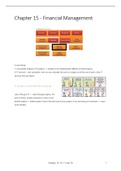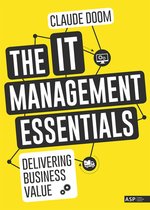Chapter 15 - Financial Management
2 main things:
1/ cost benefit analysis of IT projects => analysis is not fundamentally different of other projects.
2/ IT services – cost calculation: how can you calculate the cost of a single unit of the cost of each of the IT
services that you deliver.
IT project cost-benefit analysis
Lots of things in IT => done through projects. For
each of those: usually necessary to have a cost-
benefit analysis => before project: look at the total cost of your project. If you are doing an investment => need
some benefits.
Chapter 15, 16, 17 and 18 1
,Compare costs and benefits of IT projects
Three steps
Determine the cost of the project, of the development. Usually the upfront costs in the first phases of the project
=> development of a system => build a system
2/ benefits: what benefits is this new system going to bring our organization?
1/ Costs:
Idea: determine the cost per year over the total useful lifetime. Usually the costs are high at the beginning:
develop software for example, new servers, installation, organize training… lower during the operational phase
of the system (period system is used). Difficult to estimate total lifetime. Usually: 5-7 years, although many
systems that have a long eco lifetime.
Suppose you are project manager & you have to create a cost-benefit analysis => your problem is that you have
to create this C-B analysis before a single euro is spend. You don’t know what is going to developed, but still
have to make an estimate of the cost. How can you do that? => several ways.
Example: compare to other projects: knows what a typical ERP system will cost.
Compare current systems: often if you develop a new IT system, this new system replaces an existing IT system
=> might have an estimate in the books of the total money spend on the existing system.
Cost studies in literature: look into books, articles… => find cost studies: typical implementation of software
costs, divide software into function points and you know that one function point is about one day of
development => these metrics that have been measured in the literature => use them to estimate the total cost
of your project.
Previous approaches = top-down: you start from general idea of what such a project costs.
Bottom-up = TCO = total cost of ownership = you look at all the different phases of your project, you know the
lifecycle (conception, architecture…) and for each of these => look at the detailed costs that you expect.
Architecture for example have to pay an architect for that many months; development: programmers, testing,
developers…
Chapter 15, 16, 17 and 18 2
,Estimate all these costs and efforts => add them up and gives you the TCO = total cost of project. Lot of work
but might be most detailed way of budgeting the cost of project.
What will be the benefits of the IT system that we are developing?
Same approach: you determine the benefits per year over the total useful life.
Only have benefits during the operational phase.
How? IT systems have three kinds of benefits
1/ operational: increases in operational efficiency => staff reductions: if we have this new system => will need 10
staff members less for example. We don’t have to pay the salary of these staff members.
2/ tactical: increased customer satisfaction… => organization is able to reach its goals more efficiently.
Not all benefits = quantifiable = not expressible in money.
Tactical benefits: more different. Increasing revenue ok => 2%; but if you say ‘our customers will be more
satisfied because our salespeople can inform our customers better about lead times, prices…’ how much
money yield that me? Difficult to estimate. Can try to estimate.
Essential: per year, you have an estimate in money of the benefits of your projects.
Chapter 15, 16, 17 and 18 3
, Cash flow: for each year => cash flow.
Negative at the start: lots of costs & low benefits
Operations: cost lower & benefits increase.
If not positive during the operational part of project => won’t be profitable. Least you need.
NPV = takes all the cash flows, but discounted. Discounted with a nominal interest rate. These are discounted
cashflows that are added up. Total value of project in today’s money taking into account an interest rate i.
Idea: NPV > 0 => means that it worthwhile doing this project => LT: benefits (discounted) are larger than my
costs.
Second parameter: IRR = this interest rate for which the NPV = 0 => usually if you have a large negative CF at
the beginning & positive in further years: then as your discount rate rises, your NPV decreases => reach a point
at which = 0 = IRR.
Typical criteria for acceptable project:
1/ NPV > 0 (or threshold (100,000 euro for example))
2/ IRR has to be larger than some threshold value. If it is smaller than 0.1% => could better put money on the
bank => better return. Needs to have a minimum interest rate.
What do you use as i? interest rate of the bank? Is it the ir for a loan? Or even larger? Organisations can use ir
above 10%: profitability needs to be at least 10% if not, don’t do it => they include a risk factor into their ir.
Premium for the risk of the project. If I invest in the IT project, then this brings a certain risk => fail => lose
money. This risk is worth a few interest points. 2-3% typically.
Chapter 15, 16, 17 and 18 4





